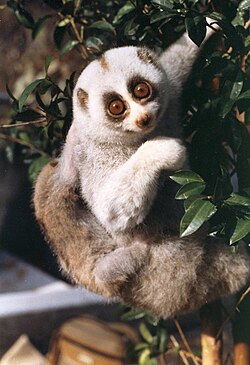Portal:Primates
The Primates Portal A primate is a member of the biological order Primates, the group that contains lemurs, the aye-aye, lorisids, galagos, tarsiers, monkeys, and apes, with the last category including great apes. With the exception of humans, who inhabit every continent on Earth, most primates live in tropical or subtropical regions of the Americas, Africa and Asia. Primates range in size from the 30-gram (1 oz) pygmy mouse lemur to the 200-kilogram (440 lb) mountain gorilla. According to fossil evidence, the primitive ancestors of primates may have existed in the late Cretaceous period around 65 mya (million years ago), and the oldest known primate is the Late Paleocene Plesiadapis, c. 55–58 mya. Molecular clock studies suggest that the primate branch may be even older, originating in the mid-Cretaceous period around 85 mya. Primates exhibit a wide range of characteristics. Some primates do not live primarily in trees, but all species possess adaptations for climbing trees. Locomotion techniques used include leaping from tree to tree, walking on two or four limbs, knuckle-walking, and swinging between branches of trees (known as brachiation). Primates are characterized by their large brains relative to other mammals. These features are most significant in monkeys and apes, and noticeably less so in lorises and lemurs. Many species are sexually dimorphic, which means males and females have different physical traits, including body mass, canine tooth size, and coloration.
Selected article
The giant mouse lemurs (Mirza) are a genus of strepsirrhine primates. Two species have been formally described; the northern giant mouse lemur (Mirza zaza) and Coquerel's giant mouse lemur (Mirza coquereli). Like all other lemurs, they are native to Madagascar, where they are found in the western dry deciduous forests and further to the north in the Sambirano and Sahamalaza regions.
Giant mouse lemurs are about three times larger than mouse lemurs, weighing approximately 300 g (11 oz), and have a long, bushy tail. They are most closely related to mouse lemurs within Cheirogaleidae, a family of small, nocturnal lemurs. Giant mouse lemurs sleep in nests during the day and forage alone at night for fruit, tree gum, insects, and small vertebrates. Home ranges often overlap, with related females living closely together while males disperse. Giant mouse lemurs are vocal, although they also scent mark using saliva, urine, and secretions from the anogenital scent gland. Predators of giant mouse lemurs include the Madagascar buzzard, Madagascar owl, fossa, and the narrow-striped mongoose. Giant mouse lemurs reproduce once a year, with two offspring born after a 90-day gestation. Babies are initially left in the nest while the mother forages, but are later carried by mouth and parked in vegetation while she forages nearby. In captivity, giant mouse lemurs will breed year-round. Their lifespan in the wild is thought to be five to six years. Both species are listed as endangered due to habitat destruction and hunting. Selected picture The white-fronted capuchin, Cebus albifrons, is a species of capuchin monkey, a type of New World primate, found in seven different countries in South America: Bolivia, Brazil, Colombia, Venezuela, Ecuador, Peru, and Trinidad and Tobago. The species is divided into several different subspecies, though the specific divisions are uncertain and controversial. CategoriesSelected species Vulnerable (IUCN 3.1)|Vulnerable The Bengal slow loris (Nycticebus bengalensis) or northern slow loris is a strepsirrhine primate and a species of slow loris native to the Indian subcontinent and Indochina. Its geographic range is larger than that of any other slow loris species. Considered a subspecies of the Sunda slow loris (N. coucang) until 2001, phylogenetic analysis suggests that the Bengal slow loris is most closely related to the Sunda slow loris. However, some individuals in both species have mitochondrial DNA sequences that resemble those of the other species, due to introgressive hybridization. It is the largest species of slow loris, measuring 26 to 38 cm (10 to 15 in) from head to tail and weighing between 1 and 2.1 kg (2.2 and 4.6 lb). Like other slow lorises, it has a wet nose (rhinarium), a round head, flat face, large eyes, small ears, a vestigial tail, and dense, woolly fur. The toxin it secretes from its brachial gland (a scent gland in its arm) differs chemically from that of other slow loris species and may be used to communicate information about sex, age, health, and social status. The Bengal slow loris is nocturnal and arboreal, occurring in both evergreen and deciduous forests. Its presence in its native habitat indicates a healthy ecosystem. It is a seed disperser and pollinator, as well as a prey item for carnivores. Its diet primarily consists of fruit, but also includes insects, tree gum, snails, and small vertebrates. In winter, it relies on plant exudates, such as sap and tree gum. The species lives in small family groups, marks its territory with urine, and sleeps during the day by curling up in dense vegetation or in tree holes. It is a seasonal breeder, reproducing once every 12–18 months and usually giving birth to a single offspring. For the first three months, mothers carry their offspring, which reach sexual maturity at around 20 months. The Bengal slow loris can live up to 20 years. The species is listed as "Vulnerable" on the IUCN Red List, and is threatened with extinction due to a growing demand in the exotic pet trade and traditional medicine. Did you know?
Primate lists
WikiProjectsThings to do
Associated WikimediaDiscover Wikipedia using portals
|

















